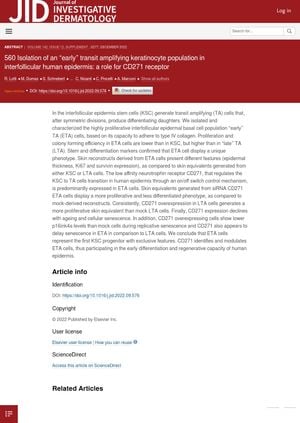Isolation of an Early Transit Amplifying Keratinocyte Population in Interfollicular Human Epidermis: A Role for CD271 Receptor
November 2022
in “
Journal of Investigative Dermatology
”
keratinocyte interfollicular epidermis CD271 receptor transit amplifying cells keratinocyte stem cells skin equivalents senescence marker p16ink4a proliferative phenotype differentiated phenotype skin cells skin layers neurotrophin receptor progenitor cells stem cells skin models aging marker p16 growth phenotype mature phenotype

TLDR Scientists found a new type of skin cell that could help with skin repair and these cells work better with a certain protein.
The study isolated and characterized a highly proliferative cell population in the interfollicular epidermal basal layer, known as "early" transit amplifying (ETA) cells. These cells have a unique phenotype, with lower proliferation and colony forming efficiency than keratinocyte stem cells (KSC), but higher than "late" transit amplifying (LTA) cells. The low affinity neurotrophin receptor CD271, which regulates the transition from KSC to TA cells, is predominantly expressed in ETA cells. Skin equivalents generated from ETA cells with suppressed CD271 expression showed a more proliferative and less differentiated phenotype. Overexpression of CD271 in LTA cells led to a more proliferative skin equivalent. CD271 expression declines with ageing and cellular senescence, and overexpressing cells showed lower levels of the senescence marker p16ink4a. CD271 also appears to delay senescence in ETA cells compared to LTA cells. The study concludes that ETA cells are the first identified KSC progenitor with unique features, and CD271 plays a role in early differentiation and regenerative capacity of human epidermis.

